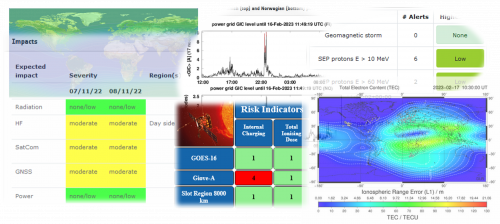Tailored space weather service information is offered through prototype dashboards in combination with expert analysis, that form the basis of a tailored bulletin that is disseminated to the user by email or SMS during periods of significantly increased solar activity.
Specific attention is given to the impact of high energy particles to satellite instrument components causing electrostatic discharges and (non) ionising effects, that may lead to data corruption, malfunctioning or even destruction of electronic devices.
Warning and alert messages
When the Earth’s magnetosphere is hit by a solar coronal mass ejection, the ionosphere is severely disturbed and radio communication and/or navigation may become unreliable or even drop out.
The compressed magnetosphere may induce strong currents in the ground that may significantly impact the operation of power grids. Operators receive warning and alert messages to get prepared for taking mitigation steps if needed. In addition, support is provided for post-event analysis in case anomalies have been detected in the system due to space weather.
Our society uses today advanced (ground and space based) technologies that, in some cases, can be vulnerable to space weather phenomena. Space weather is no longer only an economic risk but has also become a safety risk, especially with regard to the operation of power plants and the use of GNSS for air and ground transport.
Our ultimate goal is to establish a close relationship with the end user to increase awareness on space weather impacts, to ensure its progress from awareness to agreement, and finally from agreement to the adoption of evidence-based.
Acknowledgements
This work was carried out in the frame of ESA Space Safety Programme - Space Weather Service Network Development and Pre-Operation (part 1), supported under ESA contract number 4000134036/21/D/MRP.

